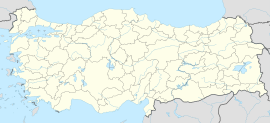Güngören, Midyat
Güngören | |
|---|---|
 | |
| Coordinates: 37°19′08″N 41°33′22″E / 37.319°N 41.556°E | |
| Country | Turkey |
| Province | Mardin |
| District | Midyat |
| Population (2022)[1] | 174 |
| Time zone | UTC+3 (TRT) |
Güngören (Kurdish: Keferb, Syriac: Kafarbe)[nb 1] is a village in the municipality and district of Midyat, Mardin Province in Turkey.[3] It is located in the historical region of Tur Abdin.[4] Güngören is populated by Arameans and by Kurds of the Dermemikan tribe.[5] The village had a population of 174 in 2022.[1]
In the village, there is a church of Mor Stephanos and Mor Yuhannon.[6]
Etymology
[edit]The Syriac name of the village is derived from "kefr" ("village" in Syriac).[7]
History
[edit]Kafarbe (today called Güngören) is attested in an inscription from AD 776/777 (AG 1088) at the nearby Mor Gabriel Monastery by its alternative name of Fōfyāth.[8][nb 2] The inscription records the placement of a bread trough at the monastery by Isaiah of Fōfyāth, shawshbino (relative by sponsorship) of Mor Zechariah of ‘Ayn-Wardo, who had been a disciple of Mor Simeon of the Olives (d. 734).[8] An inscription at the Church of Mor Stephanos and Mor Yuhannon, dated to AD 779, indicates it was either built or extensively rebuilt in that year.[10] It has been suggested that much of the church's nave was likely rebuilt in 1465.[6]
In the 18th century, the village was settled by Dermemikan Kurds from Doğubayazıt.[11]
Kafarbe was inhabited by 200 Syriac Orthodox Arameans prior to the First World War, according to Agha Petros.[12] Amidst the Sayfo in 1915, the Arameans were warned by their Kurdish neighbours to flee and thus 70 Arameans took refuge at the nearby Mor Gabriel Monastery and a Kurdish attack on the village in that year failed.[13] They remained at the monastery until the autumn of 1917, when they were captured following an assault on the monastery by Kurds of the Azzam clan led by Shandi.[14] They were taken to their own parish church where they were then murdered.[12] Only a few Arameans survived the massacre; some had fled to ‘Ayn-Wardo.[15]
In 1922, Aramean and Kurdish villagers of Kafarbe fought together to successfully expel the Kurds that had occupied the Mor Gabriel Monastery.[16] In the 1970s, the Aramean and Kurdish villagers came into conflict with one another, which led the former to emigrate abroad to Germany and the Netherlands.[17]
Demography
[edit]| Year | Pop. | ±% p.a. |
|---|---|---|
| 1985 | 268 | — |
| 1990 | 296 | +2.01% |
| 1997 | 268 | −1.41% |
| 2007 | 213 | −2.27% |
| 2012 | 190 | −2.26% |
| 2017 | 176 | −1.52% |
| 2022 | 174 | −0.23% |
| Source: 1985 census,[18] 1990 census,[19] 1997 census[20] and TÜIK (2007-2022)[1] | ||
References
[edit]Notes
Citations
- ^ a b c "Population Of Municipalities, Villages And Quarters". TÜIK. Retrieved 24 March 2023.
- ^ Gaunt (2006), p. 231; Barsoum (2008), p. 15; Courtois (2013), p. 147; Sinclair (1989), p. 328.
- ^ "Türkiye Mülki İdare Bölümleri Envanteri". T.C. İçişleri Bakanlığı (in Turkish). Retrieved 19 December 2022.
- ^ Barsoum (2008), p. 15.
- ^ Tan (2018), p. 132.
- ^ a b Sinclair (1989), p. 328.
- ^ Keser Kayaalp (2021), p. 163.
- ^ a b Palmer (1990), pp. 163, 214–215.
- ^ Barsoum (2008), p. 16.
- ^ Sinclair (1989), p. 438; Keser Kayaalp (2021), p. 186.
- ^ Tan (2018), p. 234.
- ^ a b Gaunt (2006), p. 231.
- ^ Gaunt (2006), pp. 231, 247; Brock (2012), p. 192; Çetinoğlu (2018), p. 186.
- ^ Gaunt (2006), pp. 231, 247; Çetinoğlu (2018), p. 186.
- ^ Gaunt (2006), pp. 202, 231.
- ^ Biner (2019), p. 134.
- ^ Courtois (2013), p. 147; Biner (2019), p. 134.
- ^ "1985 General Census" (PDF) (in Turkish). Turkish Statistical Institute. 1986. Archived (PDF) from the original on 22 May 2021.
- ^ "1990 General Census" (PDF) (in Turkish). Turkish Statistical Institute. 1991. Archived (PDF) from the original on 31 August 2021.
- ^ "1997 Population Count" (PDF) (in Turkish). Turkish Statistical Institute. 1999. Archived (PDF) from the original on 30 October 2022.
Bibliography
[edit]- Barsoum, Aphrem (2008). The History of Tur Abdin. Translated by Matti Moosa. Gorgias Press. Retrieved 1 April 2021.
- Biner, Zerrin Ozlem (2019). States of Dispossession: Violence and Precarious Coexistence in Southeast Turkey. University of Pennsylvania Press.
- Brock, Sebastian (2012). "The Monastery of Mor Gabriel: A Historical Overview and its Wider Significance Today". In Pieter Omtzigt; Markus K. Tozman; Andrea Tyndall (eds.). The Slow Disappearance of the Syriacs from Turkey and of the Grounds of the Mor Gabriel Monastery. LIT Verlag Münster. pp. 181–200.
- Çetinoğlu, Sait (2018). "Genocide/ Seyfo – and how resistance became a way of life". In Hannibal Travis (ed.). The Assyrian Genocide: Cultural and Political Legacies. Translated by Abdulmesih BarAbraham. Routledge. pp. 178–191.
- Courtois, Sébastien de (2013). "Tur Abdin : Réflexions sur l'état présent descommunautés syriaques du Sud-Est de la Turquie,mémoire, exils, retours". Cahier du Gremmamo (in French). 21: 113–150.
- Gaunt, David (2006). Massacres, Resistance, Protectors: Muslim-Christian Relations in Eastern Anatolia during World War I. Gorgias Press. Retrieved 21 May 2023.
- Keser Kayaalp, Elif (2021). Church Architecture of Late Antique Northern Mesopotamia.
- Palmer, Andrew (1990). Monk and Mason on the Tigris Frontier: The Early History of Tur Abdin. Cambridge University Press. Retrieved 15 July 2020.
- Sinclair, T. A (1989). Eastern Turkey: An Architectural & Archaeological Survey. Vol. III.
- Tan, Altan (2018). Turabidin'den Berriye'ye. Aşiretler - Dinler - Diller - Kültürler (in Turkish). ISBN 9789944360944.

